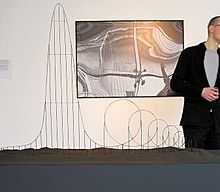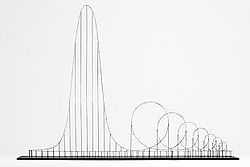Euthanasia Coaster
| Euthanasia Coaster | |
|---|---|
|
Scale model of the Euthanasia Coaster, showing its lift hill and seven inversions. | |
| Status | Concept |
| General statistics | |
| Type | Steel |
| Designer | Julijonas Urbonas |
| Model | Strata coaster |
| Lift/launch system | Cable lift hill |
| Height | 510 m (1,670 ft) |
| Drop | 500 m (1,600 ft) |
| Length | 7,500 m (24,600 ft) |
| Speed | 360 km/h (220 mph) |
| Inversions | 7 |
| Duration | 3:20 |
The Euthanasia Coaster is an art concept for a steel roller coaster designed to kill its passengers.[1] In 2010, it was designed and made into a scale model by Julijonas Urbonas, a PhD candidate at the Royal College of Art in London. Urbonas, who has worked at an amusement park, stated that the goal of his concept roller coaster is to take lives "with elegance and euphoria".[2] As for practical applications of his design, Urbonas mentioned "euthanasia" or "execution".[3] John Allen, who served as president of the Philadelphia Toboggan Company, inspired Urbonas with his description of the "ultimate" roller coaster as one that "sends out 24 people and they all come back dead".[4] As it would kill its passengers, it was criticised by the anti-euthanasia association Care Not Killing.[5]
Design

The concept design of the layout begins with a steep-angled lift to the 510-metre (1,670 ft) (0.317 mile) top, which would take two minutes for the 24-passenger train to reach.[1] From there, a 500-metre (1,600 ft) drop would take the train to 360 kilometres per hour (220 mph), close to its terminal velocity, before flattening out and speeding into the first of its seven slightly clothoid inversions.[3] Each inversion would have a smaller diameter than the one before in order to maintain the lethal 10 g to passengers while the train loses speed. After a sharp right-hand turn the train would enter a straight, where unloading of corpses and loading of new passengers could take place.[3]
The coaster design is drastically high. Its 510 m height would be enough to place it 10th in the list of tallest structures ever constructed, ahead of even the Petronas Towers.[note 1]
Pathophysiology
The Euthanasia Coaster would kill its passengers through prolonged cerebral hypoxia, or insufficient supply of oxygen to the brain.[1] The ride's seven inversions would inflict 10 g on its passengers for 60 seconds – causing g-force related symptoms starting with gray out through tunnel vision to black out and eventually g-LOC (g-force induced loss of consciousness).[3] Subsequent inversions would serve as insurance against unintentional survival of particularly robust passengers.[3]
Exhibition
Urbonas's concept drew media attention when shown as part of the HUMAN+ display at the Science Gallery in Dublin from April through June 2011.[1] The display, designated as its 2011 'flagship exhibition' by the Science Gallery,[6] aims to show the future of humans and technology.[7] Within this theme, the Euthanasia Coaster highlights the issues that come with life extension.[8]
Popular culture
On 14 June 2013, Norwegian rock group Major Parkinson released "Euthanasia Roller Coaster", a digital single with lyrics alluding to Urbonas's Euthanasia Coaster.[9]
Lavie Tidhar's short story "Vladimir Chong Chooses to Die" incorporates Urbonas's Euthanasia Coaster into the ending.[10]
Note
- ↑ Burj Khalifa, Tokyo Skytree, Warsaw Radio Mast, Shanghai Tower, KVLY-TV mast, Abraj Al Bait Towers, Canton Tower, CN Tower, Ostankino Tower. See List of tallest buildings and structures in the world
References
- ↑ 1.0 1.1 1.2 1.3 Solon, Olivia (6 April 2011). "The Future of the Human Species Explored". WIRED Science. Condé Nast Publications. Retrieved 24 April 2011.
- ↑ Lamar, Cyriaqe (18 April 2011). "The Euthanasia Coaster, the Last Roller Coaster You'll Ever Ride". Gawker Media. Retrieved 24 April 2011.
- ↑ 3.0 3.1 3.2 3.3 3.4 "Euthanasia Coaster". 2 October 2010. Retrieved 24 April 2011.
- ↑ "A Rollercoaster Designed to Kill Humanely". DesignTaxi. Halls Create Arts Pte Ltd. 20 April 2011. Retrieved 23 April 2011.
- ↑ "Euthanasia Roller Coaster Designed to Kill Riders". Metro UK. Associated Newspapers Ltd. 26 April 2011. Retrieved 26 April 2011.
- ↑ "HUMAN+ The Future of Our Species". Trinity College Dublin. 1 February 2011. Retrieved 24 April 2011.
- ↑ Sheridan, Cormac (15 April 2011). "HUMAN+ Forecasting Our Future". NewScientist Culturelab. Reed Business Information Ltd. Retrieved 24 April 2011.
- ↑ Gorman, Michael John (22 April 2011). "HUMAN+ explores the technologically enhanced future of our species". Notes and Theories: Dispatches from the Science Desk. Guardian News and Media Ltd. Retrieved 24 April 2011.
- ↑ "Major Parkinson er tilbake" Bergensavisen. Bergensavisen AS 23 July 2013. Retrieved 6 August 2013
- ↑ Analog Science Fiction and Fact –September 2014 – Vol. CXXXIV No. 9
